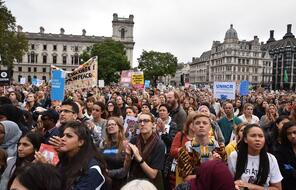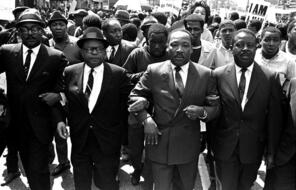Shifting Demographics in the United States
At a Glance
Subject
- Social Studies
- Democracy & Civic Engagement
Just as it has changed throughout history, the identity of the United States continues to evolve. The next chapter of the American narrative is being written by an increasingly diverse population. The excerpts below, taken from a Pew Research Center article on top demographic trends currently shaping the United States and the world, explore some of the population shifts that will affect this narrative.
Americans are more racially and ethnically diverse than in the past, and the U.S. is projected to be even more diverse in the coming decades. By 2055, the U.S. will not have a single racial or ethnic majority. Much of this change has been (and will be) driven by immigration. Nearly 59 million immigrants have arrived in the U.S. in the past 50 years, mostly from Latin America and Asia. Today, a near-record 14% of the country’s population is foreign born compared with just 5% in 1965. Over the next five decades, the majority of U.S. population growth is projected to be linked to new Asian and Hispanic immigration . . .
Asia has replaced Latin America (including Mexico) as the biggest source of new immigrants to the U.S. In a reversal of one of the largest mass migrations in modern history, net migration flows from Mexico to the U.S. turned negative between 2009 and 2014, as more Mexicans went home than arrived in the U.S. . . . Meanwhile, Asians are now the only major racial or ethnic group whose numbers are rising mainly because of immigration. And while African immigrants make up a small share of the U.S. immigrant population, their numbers are also growing steadily—roughly doubling every decade since 1970.
America’s demographic changes are shifting the electorate—and American politics. The 2016 electorate [was] the most diverse in U.S. history due to strong growth among Hispanic eligible voters, particularly U.S.-born youth. There are also wide gaps opening up between the generations on many social and political issues. Young adult Millennials are much more likely than their elders to hold liberal views on many political and social issues, though they are also less likely to identify with either political party: 50% call themselves political independents.
Millennials, young adults born after 1980, are the new generation to watch. They have likely surpassed Baby Boomers (born 1946–1964) as the largest U.S. generation and differ significantly from their elders in many ways. They are the most racially diverse generation in American history: 43% of Millennial adults are non-white, the highest share of any generation. And while they are on track to be the most educated generation to date, this achievement has come at a cost: Many Millennials are struggling with student debt. In addition to the weak labor market of recent years, student debt is perhaps one reason why many are still living at home. Despite these troubles, Millennials are the most upbeat about their financial future: More than eight-in-ten say they either currently have enough money to lead the lives they want or expect to in the future.
Women’s role in the labor force and leadership positions has grown dramatically The labor force participation rate for American women has risen steadily since the 1960s. In fact, mothers were the sole or primary breadwinner in a record 40% of all households with children in 2011. The gender pay gap has narrowed over this period of time, especially for young women just entering the labor force, but it still persists. As more women have entered the workforce, the share of women in top leadership jobs has risen, but they still make up a small share of the nation’s political and business leaders relative to men. . . .
The American family is changing. After decades of declining marriage rates, the share of American adults who have never been married is at an historic high. Two-parent households are on the decline in the U.S., while divorce, remarriage and cohabitation are on the rise. About one-in-six American kids now live in a blended family. And the roles of mothers and fathers are converging, due in part to the rise of breadwinner moms. Dads are doing more housework and child care, while moms are doing more paid work outside the home. . . .
The share of Americans who live in middle class households is shrinking. The share of U.S. adults living in middle-income households fell to 50% in 2015, after more than four decades in which those households served as the nation’s economic majority. And the financial gaps between middle- and upper-income Americans have widened, with upper-income households holding 49% of U.S. aggregate household income (up from 29% in 1970) and seven times as much wealth as middle-income households (up from three times as much in 1983). . . .
Christians are declining as a share of the U.S. population, and the number of U.S. adults who do not identify with any organized religion has grown. While the U.S. remains home to more Christians than any other country, the percentage of Americans identifying as Christian dropped from 78% in 2007 to 71% in 2014. By contrast, the religiously unaffiliated have surged seven percentage points in that time span to make up 23% of U.S. adults last year. This trend has been driven in large part by Millennials, 35% of whom are religious “nones.” The rise of the “nones” is not a story unique to the U.S.: The unaffiliated are now the second-largest religious group in 48% of the world’s nations. . . . 1
- 1D'Vera Cohn and Andrea Caumont, "10 demographic trends that are shaping the U.S. and the world," Pew Research Center, Fact Tank: News in the Numbers(blog), March 31, 2016.
How to Cite This Reading
Facing History & Ourselves, “Shifting Demographics in the United States,” last updated June 17, 2017.
This reading contains text not authored by Facing History & Ourselves. See footnotes for source information.













